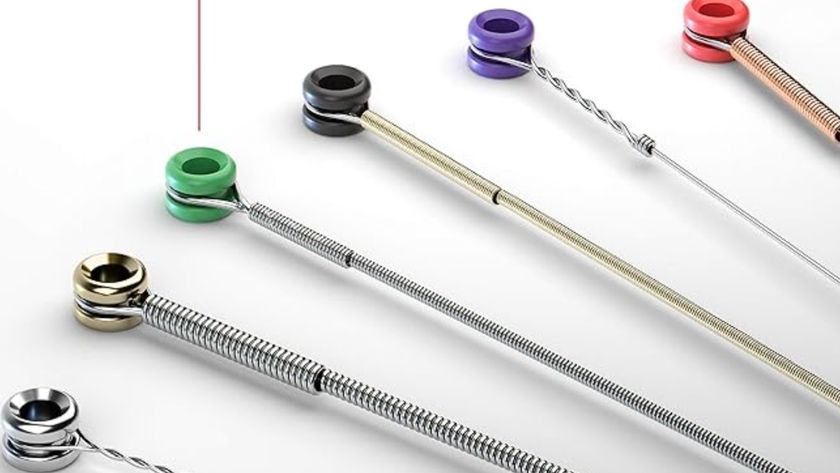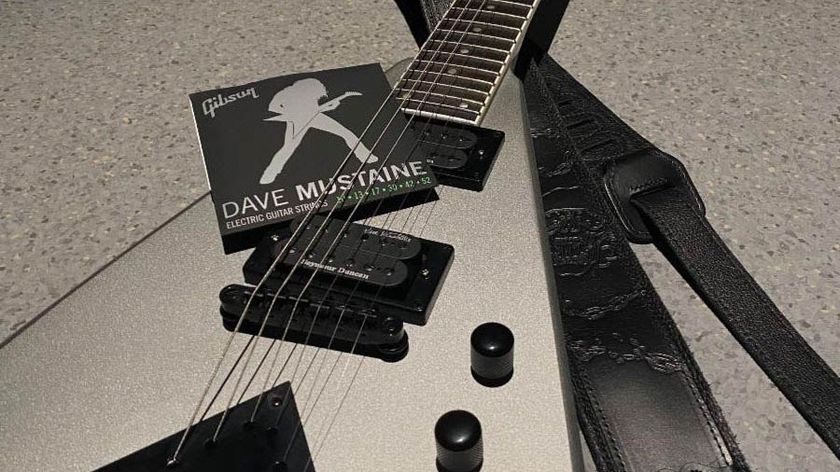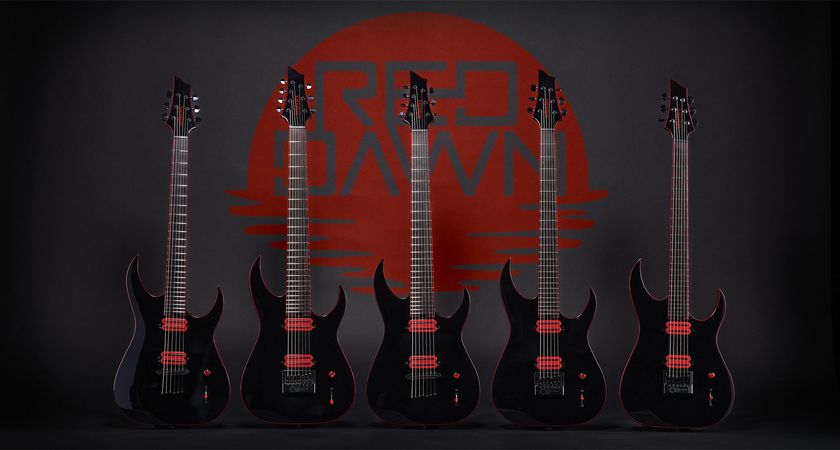Best guitar strings 2025: A beginner’s guide to all things strings
Everything you need to know about guitar strings and how to find the right set for your acoustic, electric or nylon-string guitar
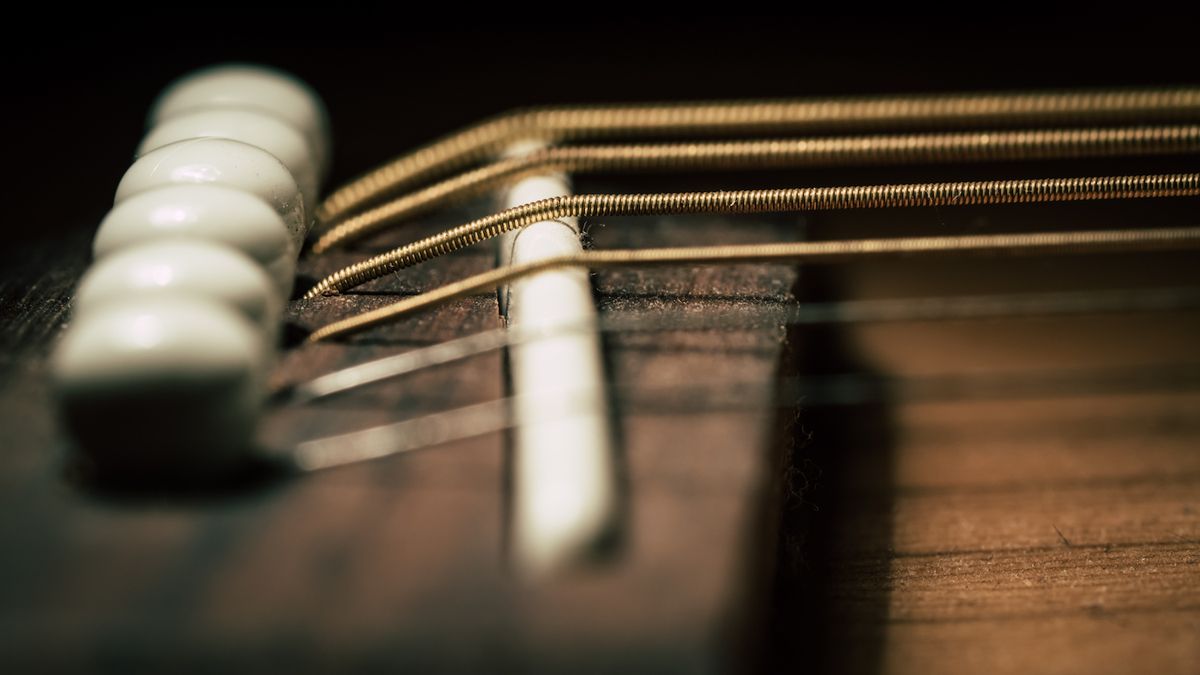
You will often find us talking about essential pieces of gear, y’know, why you need to have a guitar tuner (you do), or a distortion pedal that’s a pedalboard must-have (hmm, probably). But at the risk of stating the obvious, guitar playing is nothing without strings. No strings, no life, as they say. And that’s why, if you’re not sure where to start, we’ve compiled this guide to the best guitar strings on the planet right now.
Strings are fundamental to guitar playing, but if you are just starting your journey as a guitar player, finding the right set of strings can be a little bewildering. There is a lot of choice to work your way through.
Here we are going to explain the different types of strings – for electric guitar, acoustic guitar and nylon-stringed guitar – what to consider when choosing a set of strings, and, indeed, underscore just how important it is that you think about your strings as a crucial component of your sound and your playing experience.
After all, your choice of guitar string will affect how your instrument will sound, and just as important for a beginner, when you are building strength in your fingers and calluses on fingertips, it affects how your instrument feels. We will also recommend a few sets to help you get started.
Know which guitar strings you’re looking for?
MusicRadar's got your back
- Here’s our pick of the best acoustic guitar strings…
- And the best electric guitars strings
- Freshen up your uke with the best ukulele strings
- Best nylon guitar strings: top sets for classical, hybrid and flamenco players
Buying advice
Best guitar strings: a primer
In ye olden times, guitar strings were fashioned out of animal guts. You might have heard of the so-called ‘catgut strings’? Well, those were ubiquitous for guitar players until the early 1900s.
The good news is that there’s no need for the feline in your life to get bent out of shape whenever you open the guitar case. For a start, catgut was a euphemism. Typically the first strings were spun from the intestines of cattle, goats and so on (you can climb down off the bookshelf now, Mog). And more to the point, in 2020, string manufacture is down to a fine art using a variety of materials such as various metals, nylon and silk, with all manner of technological advanced treatments and coatings to preserve their life.
Electric vs acoustic vs nylon guitar strings
Guitar strings fall into three categories – electric, acoustic and nylon. Electric guitar strings are made from metal – typically steel or nickel – with the top three strings plain steel and the bottom three featuring a steel core with a metal wrap, often nickel as it has a bright tone and, being softer than steel, is easier on your frets.
Acoustic guitar strings are also made from metal, usually bronze, phosphor bronze, brass, nickel, silk or steel. The top two strings are typically plain steel, with the bottom four a wrapped construction that might typically see a steel core wrapped with bronze. Some sets, such as Ernie Ball’s Earthwood Extra Soft and Le Bella’s Silk And Steel, use silk between the metal core and the wrap to give it a softer feel and reduce string squeak when playing.
Phosphor bronze is a popular choice for acoustic strings. Here, phosphor is added to the alloy to extend the string’s life. Manufacturers have been in an arms race to develop longer-lasting strings. Elixir have staked a reputation for developing coated strings, providing a natural feel and tone but often dramatically extending the life of the strings. These, and sets such as Ernie Ball’s Paradigm and D’Addario’s EXP, offer excellent options for both electric and acoustic players, but they do come at a price.
Nylon strings are a little different. Where the acoustic and electric strings have ball-ends that secure the string to the bridge, nylon strings are looped around the bridge in a simple knot, then looped through the tuning roller at the headstock before bringing them up to pitch.
Nylon strings are used on classical, Flamenco and hybrid guitars. Here, the top three strings are made from clear or rectified nylon, with the bottom three typically using bronze or silver-plated copper wire wrapped around a multi-filament core. They feel softer underneath your fingers and have a more mellow tone.
Just listening to some audio of an electric, an acoustic and a classical guitar will give you an idea of how these strings and their materials affect the instrument’s tone.
Gauges
What guitar string gauges should you use?

In standard tunings, the guitar strings are ordered E A D G B E. The low E, aka the sixth string, is the thickest. The high E, aka the first string, is the thinnest. Because the thickness of the string is related to its tension when it is brought up to pitch, we use thicker strings for low notes and thinner strings for high notes.
If we were to use a high E with a diameter of 0.009 inches for the G string, for example, it would not have the sufficient tension to make it playable when it’s brought up to pitch.
This correlation between the string gauge and tension is worth bearing in mind when considering how gauges affect the guitar’s tone and the instrument’s playability.
String gauges are measured in 1/1000s of an inch and correspond to the diameter of a string. For a light set of electric guitar strings, the string gauges might run high to low, .009 to .042.
These will have an easy feel. There is a little less string tension, less string for your fingertips to manage, and with these advantages it is no surprise that shredders often favour lighter gauge strings; you will find lighter strings easier to bend.
If you are just starting out on the instrument, an extra-light set of “9s” on your electric guitar will be more accommodating to fingers that are yet to develop the strength and calluses on your fingertips. Note: when we talk about sets of strings, typically we refer to them by their lightest string gauge – e.g. “Hello, friendly guitar shop sales assistant! A packet of D’Addario XL 9s please, boss.”
A generic guide to electric guitar string gauges
- Extra light: .008, .010, .015, 021, .030, .038
- Light: .009 .011 .016 .024 .032 .042
- Medium: .010 .013 .017 .026 .036 .046
- Heavy: .011 .015 .022 .030 .042 .054
- Extra heavy: 012, .016 .020, .034, .046, .060
Are there implications for your tone? A little. A set of “10s”, which might run from .010” to .046,” might offer a little more depth, volume and sustain to your tone, and maybe just a smidgen less treble. And comparing a heavy electric set of “12s” to your extra-light “9s” you will notice they are very much harder to manage but there is a bit more oomph in terms of volume and sustain.
These differences are more pronounced on acoustic guitars where the string is doing a lot more work in generating the volume.
With nylon strings, the gauge is typically generalised into light tension, medium tension and hard tension. While nylon is a lot kinder to inexperienced fingers, perhaps a light or medium tension set would be the best starting point. They might sound a little mellower but feel more inviting.
A generic guide to acoustic guitar string gauges
- Extra light: .010 .014 .023 .030 .039 .047
- Custom light: .011 .015 .023 .032 .042 .052
- Light: .012 .016 .025 .032 .042 .054
- Medium: .013 .017 .026 .035 .045 .056
- Heavy: .014 .018 .027 .039 .049 .059
You will find a preference with experience. As ever, the rule with gear is: if it feels good and sounds right, it is right. Once you build up that finger strength, you might opt to go down the Stevie Ray Vaughan route with a heavyweight set on your electric. Or if you intend on downtuning your guitar, a thicker gauge string will help keep your tone solid – D’Addario has a special set of “12s” for tuning down to C. No matter what you want to do with your guitar, there is a gauge for you.
Changing strings
How often should I change my guitar strings?
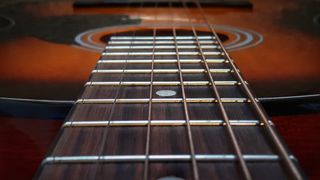
This is usually a matter of individual preference. Wiping you strings with a dry cloth after each practice session will help keep them fresh. There are also special cleaners – such as GHS’ Fast Fret – that you can use to keep your strings in tip-top condition.
Over time, though, they will lose their brightness, sound a little dull, feel a little grubby, and then it will be time to replace them. When you do, you might have to bear with them. Some players love fresh strings; that is when they are at their brightest. But you might find they play better once they have settled down a little after a few hours of playing.
The key thing is to experiment. The good thing about strings is that, on the whole, they are not expensive. There are plenty of great sets offering plenty of change from a tenner for you to try, and once you find the set you like, well, maybe then you can splurge on one of those fancy schmancy coated strings.
Find out more about how we test music gear and services at MusicRadar.
Recommended products
The best guitar strings for beginners: electric
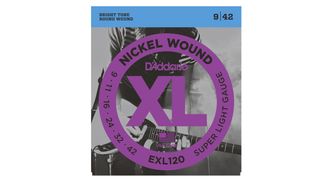
1. D’Addario XL
Specifications
Reasons to buy
Reasons to avoid
D’Addario XL’s are everywhere. When you buy a guitar, there is a decent chance they will ship with a set of XL’s on them. Helpfully, they have colour-coded ball ends, making it easy to identify which string is which (hey, we have all made that mistake when starting out).
We have recommended the Super Light set here, but D’Addario makes these in a wide variety of gauges, and you can get lighter if you wish.
Design-wise, your bottom three strings have bright-sounding nickel wraps over high-carbon steel core, plain steel on the top three. The sound lively, with plenty of harmonics, and they feel great. A classic for a reason, and cheap too.
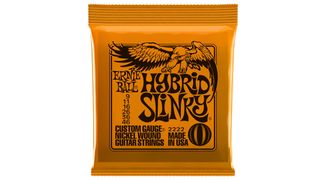
2. Ernie Ball Hybrid Slinky
Specifications
Reasons to buy
Reasons to avoid
We love Ernie Ball strings. You can find them in all kinds of gauges, but here we are recommending the Hybrid Slinky, because you still have the super light top three strings – again, like the XLs, plain steel – that are easy to bend, but the bottom three strings are a little thicker, making them an excellent choice for drop D tuning, which will no doubt be the first alternative tuning you learn.
Like the D’Addario’s, the Hybrid Slinky set is bright-sounding – perfect for rock ’n’ roll, sure, but really just a nicely made string that will suit all playing styles. And again, they’re great value.
The best guitar strings for beginners: acoustic
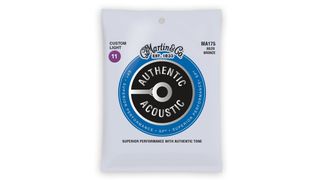
1. Martin Authentic Acoustic Custom Light
Specifications
Reasons to buy
Reasons to avoid
As with so many things acoustic, Martin were the pioneers of the steel string, and this Custom Light set – so called because it is a little unconventional with a slightly skinnier sixth string than the Light packs – is an excellent choice for a number of reasons.
First, this set is well-priced. Second, it is very durable, resistant to corrosion, and if you wipe these down they should last you a while. And third, well, they sound huge, bold and brassy. There are also lighter sets in this series should you find these a little too tough. Going down to 10s on your acoustic, you will sacrifice a bit of volume, so do try to persist with the 11s, taking a break whenever the fingertips get sore, and coming back to it. It’s amazing how quickly you build up the strength in your fingers, with the tips firming up and removing discomfort when playing.
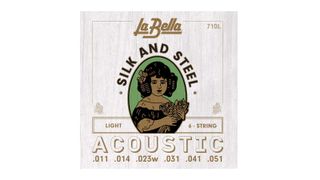
2. La Bella 710L Silk And Steel
Specifications
Reasons to buy
Reasons to avoid
The Silk and Steel set from La Bella offers something a little different. They are a little warmer sounding than pure metal strings, and feature an Italian silk filament between the metal wrap and the core to create a soft touch and feel.
While they might lack the upfront brassiness of pure metal strings, they make an excellent choice for young players, especially those playing fingerstyle, and have a warm, sweet tone. They are a little pricier than other entry-level sets, but when you are building up stamina in your fretting hand, every little helps.
The best guitar strings for beginners: nylon
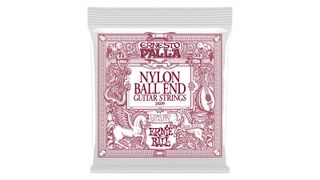
1. Ernie Ball Ernesto Palla
Specifications
Reasons to buy
Reasons to avoid
The Ernsto Palla set is an excellent starting point for your nylon-string adventures. They are made in the USA, with the bass strings comprising a silver-plated copper wrap surrounding a multi-filament nylon core, with the three treble strings made from solid monofilament clear nylon.
Tone-wise, these are bang-on, with all that beautiful mellow precision you need from a classical guitar. They are old-school in that you'll tie them at the bridge (some nylon sets these days have ball-ends) and so they will fit almost any classical, flamenco or hybrid guitar.
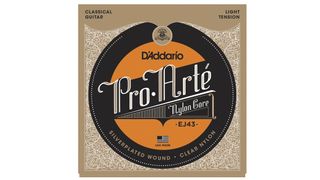
2. D’Addario Pro-Arté
Specifications
Reasons to buy
Reasons to avoid
The Pro-Arté set from D’Addario costs a little bit more but we think it rewards you with superior tone and feel and on balance this is worth the investment. They’ll keep you playing longer, and this light tension set should feel very accessible to younger players.
With nylon strings, pain in the fingertips is less of an issue. There’s less of a physical struggle, but these will help your classical picking drills build up the precision you need to master the classical guitar. There are also half-sets available, which is nice and handy as the nylon strings last that little bit longer than the wound strings.
Guitar string accessories
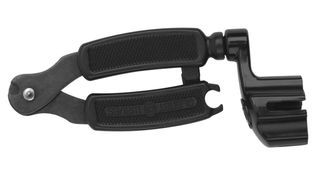
1. D’Addario Pro-Winder String Winder & Cutter
Specifications
You don’t necessarily need this but once you start using a handy little tool like this you will never go back to the wire cutter and manual approach again. The winder greatly accelerates the speed with which you can bring the strings up to pitch, while the cutter lets you snip off the loose ends and keep things nice and neat. You can get power winders, too.
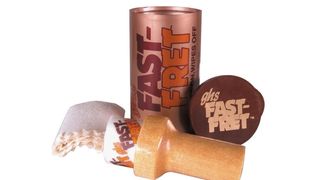
2. GHS Fast Fret
Specifications
Not much needs to be said about this product. Keep a Fast Fret tube in your gigbag at all times and clean your strings after each session. Simply put, this will extend their life.
Get the MusicRadar Newsletter
Want all the hottest music and gear news, reviews, deals, features and more, direct to your inbox? Sign up here.
Jonathan Horsley has been writing about guitars and guitar culture since 2005, playing them since 1990, and regularly contributes to MusicRadar, Total Guitar and Guitar World. He uses Jazz III nylon picks, 10s during the week, 9s at the weekend, and shamefully still struggles with rhythm figure one of Van Halen’s Panama.

